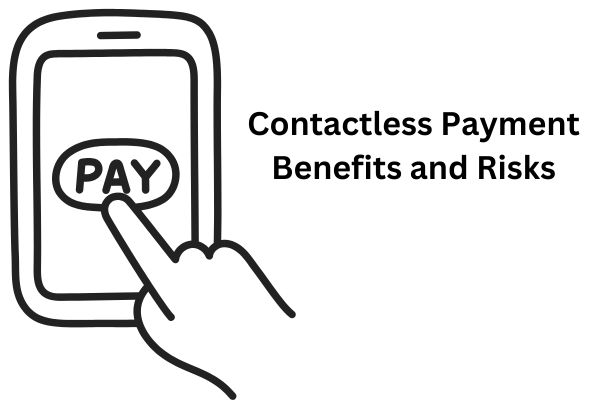As with any new technology, there are both benefits and risks associated with contactless payment. In this post, I will explore the main contactless payment benefits, potential risks, and how to protect yourself when using contactless payment.
Contactless Payment Benefits
Contactless payment technology has become increasingly popular as people seek faster, more convenient, and safer ways to make payments.
The following are some of the main perks associated with this method of payment:
Speed and Convenience
Contactless payment is much faster compared to traditional payment methods like cash. It takes just a few seconds for the payment to be processed, meaning that it’s ideal for high-traffic areas where long queues can quickly build up.
Additionally, it eliminates the need for having to carry cash, which is often slower and more burdensome.
Imagine being in a rush to catch a train or bus and having to wait in a long queue to buy a ticket. With contactless payment, you simply bring your mobile device close to the payment terminal and be on your way within seconds.
This can save you valuable time and reduce stress levels.
Improved Security Features
When making a payment with a contactless payment device, the payment terminal reads only specific details through NFC or RFID technology.
The payment device doesn’t transmit any additional personal information or banking details such as your name, address, or account balance.
These factors help to minimize the risk of identity theft, making contactless payment more secure than traditional payment methods.
Moreover, many contactless payment systems have additional security features, such as requiring a PIN or biometric authentication for transactions over a certain amount. This adds an extra layer of protection against fraud and unauthorized transactions.
Reduced Physical Contact
With the COVID-19 pandemic, the importance of contactless payment became more apparent. Contactless payment reduces the need for physical contact between people and surfaces, thus decreasing the spread of germs and viruses.
Not only does contactless payment reduce the risk of infection, but it also helps to promote social distancing measures. With fewer people needing to handle cash or touch payment terminals, the risk of transmission is significantly reduced.
Integration with Mobile Wallets and Apps
Contactless payment can easily integrate with mobile wallets and apps, allowing for a more seamless payment experience. You can store multiple payment cards on a single device and quickly switch between them, making it more convenient for people on the go.
Mobile wallets also offer additional advantages, such as the ability to track your spending, receive notifications for transactions, and redeem rewards or discounts. This can help you to manage your finances more effectively and make the most of your money.
The Risks of Contactless Payment
While contactless payments offer many benefits, such as convenience and enhanced hygiene, there are also some risks associated with this technology.
The following are some of the risks associated with a contactless method of payment:
Potential for Fraud and Theft
Like other technologies, contactless payment has its risks. Cybercriminals can steal your personal information, such as your card number or expiration date, by hacking into payment networks.
It’s important to remain vigilant and check your payment statements regularly to identify any unusual activity.
Privacy Concerns
There are concerns regarding the level of personal information that payment providers store about their customers on their servers.
Although most payment providers assure customers that their data is secure and protected, there’s still some level of risk with using these services. Some people may prefer to use traditional payment methods to avoid this risk altogether.
Technical Issues and Limitations
Technical issues, such as poor network signal or outdated software, can slow down the payment process and affect its reliability.
Also, not all payment terminals accept contactless payments, meaning that this payment method isn’t universally accessible in all areas.
Overspending and Loss of Budget Control
Contactless payment makes payments so fast and easy that you may not pay close attention to your spending habits.
Sometimes, you may spend more than originally intended, or forget all about your spending because the transactions are instant, leading to potential overspending and loss of budget control.
How to Protect Yourself When Using Contactless Payment
While contactless payments offer a convenient and secure way to make transactions, it is important to take measures to protect yourself from potential risks.
The following are measures you can take to mitigate the risks that come with contactless payments:
Keep Your Cards and Devices Secure
Ensure that you protect your payment devices with passwords or PINs. Ensure that your devices and payment methods are equipped with the latest security features, such as two-factor authentication and encryption.
Monitor Your Accounts Regularly
Regularly monitor your transactions and bank statements to identify any unauthorized activity and report suspected fraud to your bank or contactless payment service provider immediately.
Most accompanying payment apps offer notifications, making it easy to keep track of your spending and promote security.
Set Spending Limits and Alerts
To avoid overspending, consider setting limits on your contactless payments or using tools that alert you when you reach a specific spending limit. These tools can help you manage your expenses and stay within your budget.
Conclusion

Contactless payment is a fast, convenient, and secure way of making payments. It reduces exposure to germs and viruses, and it’s easily integrated with mobile wallets, making it perfect for people on the go.
However, contactless payment also has its risks, such as potential fraud and privacy concerns. By following the tips I’ve outlined in this post, you can effectively protect yourself when using contactless payment and enjoy its benefits without risking your security and privacy.
As technology continues to evolve, we can expect to see even more innovative features and improvements in the world of contactless payment – which will most likely increase contactless payment benefits and reduce associated risks.
